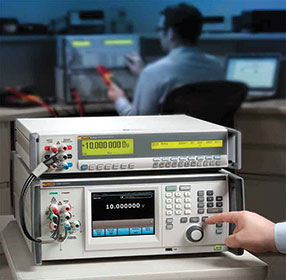

Fluke has extended its long-running series of calibrators with the new 5730A.
Like its predecessors, it calibrates a wide range of digital multimeters (up to long-scale 8,5 digit models) as well as RF voltmeters when equipped with the wideband option. What’s more, this new model features improved specifications that will help users improve test uncertainty ratios (TURs) and increase test confidence, as well as reduce the need to guardband.
The instrument is designed for calibration professionals who require the most accurate DC/LF signals available in a multifunction calibrator. Metrologists in national laboratories, the military, third-party calibration laboratories and corporate users with high-end workload can all benefit from its performance.
All 5730A calibrators are traceable to international standards and are produced in a factory with ISO/IEC 17025 accredited calibrations. Specifications are stated to the standard Fluke Calibration 99% confidence level (as well as 95% confidence level) to support easy measurement comparisons, according to international quality standards. Specifications are absolute and include the uncertainty of the calibration standards used; no additional analysis is required.
The 5730A keeps many of the front-panel details that characterise its predecessors, while adding a new full-colour touchscreen display to enhance usability and ease calibration. Users enter values via a familiar, calculator-style keyboard, working naturally from left to right.
A new graphical user interface features menus that are both easy to read and use, as well as access to common functions. Status indicators for Operate, Standby and Hazardous Voltage appear on the screen in bright letters or icons that are easily recognisable even from across the calibration lab.
The redesigned front panel features ‘Visual Connection Management’ output terminals that light up to show which terminals are active, guiding the user to make the correct connections. The handles and knob are overmoulded for comfort and feel. USB ports are placed on both the front and rear of the unit for downloading internal calibration constants and communicating with a PC.
The calibrator features artifact calibration. Only three artifact standards – a 10 V DC reference and 1 Ω and 10 kΩ resistance references – are required to calibrate all ranges and functions to full specifications. Front panel GUI instructions prompt the operator to make connections and inputs each step of the way. The calibrator controls the process, which takes only about an hour, compared to several hours using traditional calibration methods.
In addition to saving time and equipment costs, artifact calibration can extend time between calibrations of the 5730A to two years before a full verification check by a Fluke service centre is required. And, because it can tolerate operating temperatures between 15°C and 35°C, it can be calibrated where it’s used, rather than having to be shipped to a standards laboratory for calibration.
| Tel: | +27 10 595 1821 |
| Email: | [email protected] |
| www: | www.comtest.co.za |
| Articles: | More information and articles about Comtest |
© Technews Publishing (Pty) Ltd | All Rights Reserved